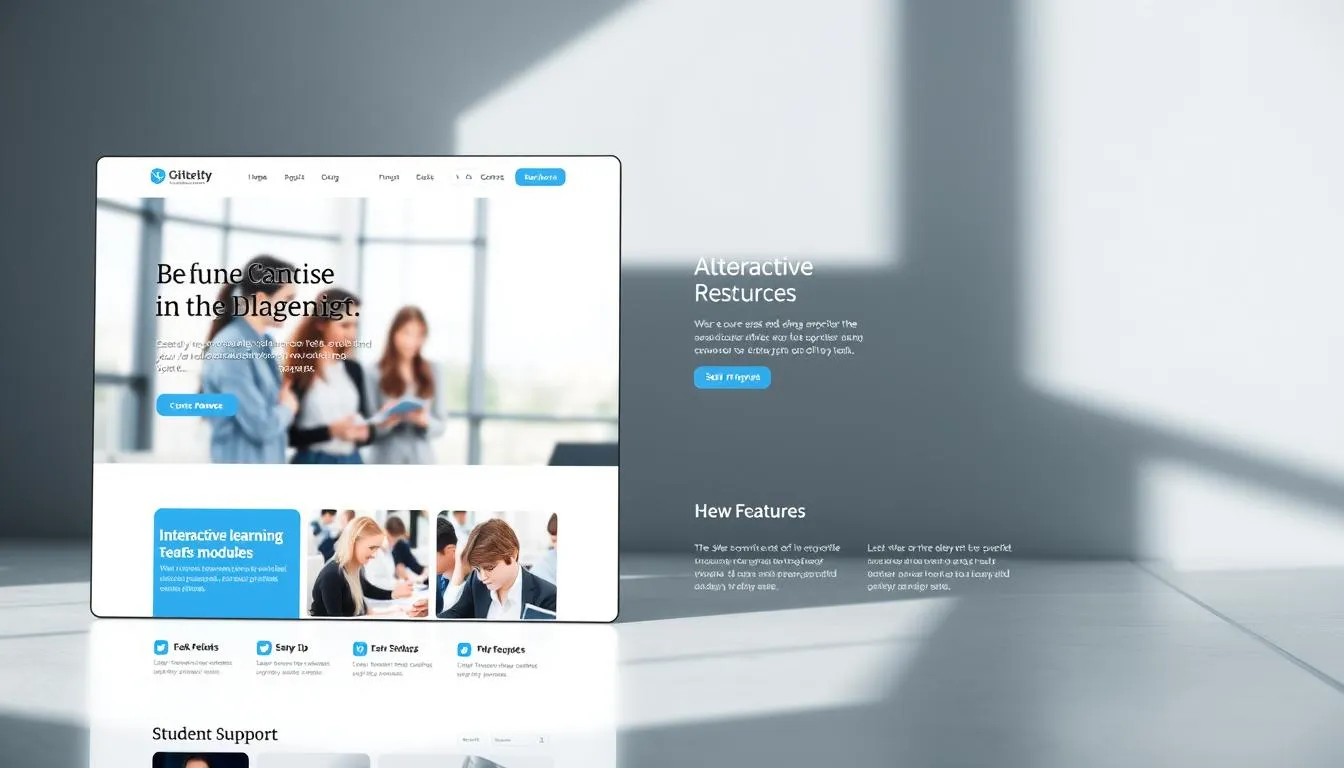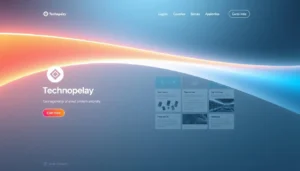Last Updated on: June 19, 2025
Creating an effective education website is crucial for attracting and engaging students. A well-designed website can make a significant difference in the learning experience.
A well-designed education website should include essential features that enhance the user experience. These features for education website will help institutions establish a strong online presence.
Key Takeaways
- Clear navigation and user-friendly interface
- Responsive design for mobile devices
- Prominent display of courses and programs
- Integration with social media platforms
- Secure online payment system
The Importance of a Well-Designed Education Website
In today’s digital age, a well-crafted education website is no longer a luxury but a necessity. A website serves as the digital face of an educational institution, often making the first impression on prospective students and their parents.
First Impressions Matter: Why Website Quality Affects Enrollment
The quality of an education website can significantly influence a prospective student’s decision to enroll. A well-designed website conveys professionalism and a commitment to quality education. Key aspects that contribute to a positive first impression include:
- Clear and intuitive navigation
- Relevant and up-to-date content
- Visually appealing design
- Mobile responsiveness
These elements work together to create a seamless user experience, encouraging visitors to explore the site further and ultimately enroll.
Understanding Your Website Users: Students, Parents, and Faculty
Understanding the diverse needs of website users is crucial for designing an effective education website. The primary users include:
- Prospective and current students seeking information on courses, admissions, and campus life.
- Parents looking for information on tuition, extracurricular activities, and support services.
- Faculty and staff requiring access to resources, course materials, and institutional updates.
By catering to these different user groups, educational institutions can ensure their website is user-friendly and informative, meeting the needs of its diverse audience.
User-Friendly Navigation and Interface Design
The key to a successful education website lies in its ability to provide an intuitive and seamless user experience through effective navigation and design. A well-structured website not only enhances user engagement but also ensures that visitors can easily find the information they need.
Intuitive Menu Structures for Different User Types
Creating intuitive menu structures is crucial for catering to different user types, including students, parents, and faculty members. By organizing content into clear categories and subcategories, educational institutions can simplify the navigation process, making it easier for users to find what they’re looking for.
Search Functionality and Site Maps
Incorporating robust search functionality and site maps can significantly enhance the user experience. This allows visitors to quickly locate specific information and navigate through the website with ease, reducing bounce rates and improving overall satisfaction.
Accessibility Compliance for Educational Institutions
Ensuring accessibility compliance is not only a legal requirement but also a moral imperative. Educational websites must be designed to be accessible to everyone, including individuals with disabilities. This involves adhering to accessibility standards and guidelines to provide an inclusive online environment.
By focusing on user-friendly navigation and interface design, educational institutions can create a positive online experience that attracts and retains students, ultimately contributing to their academic success.
Mobile Responsiveness and Cross-Platform Compatibility
The shift towards mobile browsing necessitates that educational websites be optimized for various devices and screen sizes. With the majority of internet users now accessing websites through mobile devices, a responsive design is vital for educational websites. This ensures that students, parents, and faculty can navigate the site effortlessly, regardless of the device they use.
Designing for Smartphones and Tablets
When designing for smartphones and tablets, it’s essential to consider the user experience. A mobile-responsive design adapts to the screen size of the device, ensuring that content is easily accessible. This involves using flexible grids, images, and media queries to create a seamless user interface.
Key considerations include:
- Simplifying navigation menus
- Optimizing content for smaller screens
- Ensuring that calls-to-action are prominent
Testing Across Multiple Browsers and Devices
To ensure cross-platform compatibility, it’s crucial to test your website across multiple browsers and devices. This includes checking for functionality on different operating systems, browsers, and screen sizes. A comprehensive testing strategy can help identify and fix issues before they impact users.
What Features Should an Educational Website Have? A Comprehensive Overview
When designing an educational website, it’s essential to determine which features are necessary and which are optional. An educational website serves as a central hub for information, communication, and learning, making it crucial to include the right features to meet the needs of students, parents, faculty, and staff.
Essential Features vs. Nice-to-Have Additions
Essential features for an educational website include user-friendly navigation, mobile responsiveness, and clear information architecture. These features ensure that visitors can easily find the information they need and navigate the site without difficulty. Other essential features may include online application systems, course catalogs, and faculty directories.
Nice-to-have additions can enhance the user experience and provide additional value to visitors. Examples include virtual tours, video integration, and interactive learning tools. While these features are not essential, they can help to differentiate the institution and provide a more engaging online experience.
Prioritizing Features Based on Your Institution’s Goals
Prioritizing features based on the institution’s specific goals and objectives is crucial. For example, if the institution’s goal is to increase online enrollment, features such as online course registration and digital payment processing may be a priority. On the other hand, if the goal is to enhance student engagement, features such as discussion forums and student portfolios may be more important.
By carefully evaluating the institution’s goals and prioritizing features accordingly, educational institutions can create a website that effectively supports their mission and meets the needs of their users.
Learning Management System Integration
Integrating a Learning Management System (LMS) into your educational website is a strategic move that can significantly enhance the learning experience. This integration allows for a more streamlined and efficient management of educational courses, making it easier for both instructors and students to access and manage course materials.
Seamless Course Access and Materials Distribution
A key benefit of LMS integration is the ability to provide seamless course access and distribute materials efficiently. This means students can access their course materials, lectures, and assignments from a single platform, enhancing their learning experience.
Assignment Submission and Grading Systems
LMS integration also facilitates assignment submission and grading systems, making it easier for students to submit their work and for instructors to grade and provide feedback. This streamlined process reduces administrative burdens and allows for more focused teaching and learning.
Discussion Forums and Collaborative Learning Tools
Furthermore, LMS platforms often include discussion forums and other collaborative learning tools. These features enable students to engage in meaningful discussions, share ideas, and collaborate on projects, fostering a more interactive and engaging learning environment.
By integrating these features, educational institutions can create a more cohesive and effective online learning environment, ultimately enhancing the educational experience for students.
Student Portals and Personalized Dashboards
A well-designed student portal is essential for enhancing the overall learning experience, offering a range of features tailored to individual needs. These portals serve as a one-stop-shop for students, providing access to various academic tools and resources.
Student portals typically include a variety of features that cater to different aspects of a student’s academic life. By integrating these features, educational institutions can significantly improve student engagement and satisfaction.
Registration and Course Selection Features
Registration and course selection are critical components of a student portal. These features allow students to easily browse and enroll in courses, manage their schedules, and plan their academic paths. By streamlining the registration process, institutions can reduce administrative burdens and improve student outcomes.
Progress Tracking and Grade Reporting
Another essential feature is progress tracking and grade reporting. This allows students to monitor their performance in real-time, identify areas for improvement, and stay on top of their academic responsibilities. Institutions can also use this data to provide targeted support and interventions.
Personalized Notifications and Learning Paths
Personalized notifications and learning paths are also vital components of a student portal. By tailoring communications and recommendations to individual students, institutions can enhance the learning experience and foster a more personalized approach to education. This can include alerts for upcoming deadlines, suggestions for relevant courses, and guidance on academic progress.
By incorporating these features, student portals can significantly enhance the educational experience, providing students with a more streamlined, personalized, and effective way to manage their academic lives.
Content Management and Multimedia Resources
In today’s digital age, educational institutions must prioritize content management and multimedia resources to engage their online audience effectively. A well-structured content management system allows for easy updates and maintenance of the website, ensuring that information remains current and relevant.
Dynamic Course Catalogs and Academic Programs
A dynamic course catalog is essential for any educational institution’s website. It not only lists the available courses but also provides detailed descriptions, helping prospective students make informed decisions. By integrating academic programs into the website, institutions can showcase their strengths and specializations.
Faculty Profiles and Expertise Showcases
Showcasing faculty profiles and their areas of expertise can significantly enhance the credibility of an educational institution. Detailed profiles help prospective students understand the qualifications and research interests of the faculty, creating a more personal connection.
Video Integration, Virtual Tours, and Interactive Media
The incorporation of multimedia resources such as video integration, virtual tours, and interactive media can greatly enhance the user experience. Videos can provide virtual open days, campus tours, and course previews, giving prospective students a deeper insight into the institution.
By effectively managing content and incorporating a variety of multimedia resources, educational institutions can create a more engaging and informative website. This not only improves the user experience but also aids in attracting and retaining students by showcasing the institution’s offerings in a compelling manner.
Admissions and Financial Features
In today’s digital age, having robust admissions and financial features on an education website is no longer a luxury, but a necessity. These features play a crucial role in streamlining the admissions process, making it more efficient for both the institution and prospective students.
Online Application Systems and Document Management
An effective online application system allows prospective students to easily submit their applications and required documents. This not only improves the user experience but also reduces administrative burdens. Document management features enable institutions to organize and track applicant documents efficiently, ensuring that all necessary information is collected and processed.
Tuition Payment Processing and Financial Aid Tools
Simplifying tuition payment processing is crucial for enhancing the overall experience for students and their families. Secure online payment systems allow for easy payment of tuition fees, while financial aid tools help students and parents understand their financial obligations and available aid options. This includes features like payment plans and financial aid calculators.
Scholarship Information and Application Systems
Providing clear and accessible information about available scholarships is vital for attracting top talent. Scholarship application systems enable students to apply for scholarships directly through the website, making it easier for institutions to identify and award deserving students. Detailed information about eligibility criteria, application deadlines, and award amounts should be readily available.
Security, Analytics, and Technical Considerations
With the rise of digital learning, educational websites must prioritize security, analytics, and technical considerations to provide a seamless user experience. Ensuring the security and integrity of an educational website is crucial, particularly when it comes to protecting sensitive student information.
Data Protection and Student Privacy Compliance
Compliance with data protection and student privacy regulations is not only a legal requirement but also essential for maintaining trust with students and their families. Educational institutions must adhere to regulations such as FERPA in the United States, ensuring that student data is handled and stored securely.
Best practices include implementing robust encryption, secure authentication processes, and regular security audits to identify vulnerabilities.
Performance Monitoring and User Behavior Analytics
Performance monitoring and user behavior analytics can provide valuable insights into how the website is being used. Tools like Google Analytics can help track user engagement, identify bottlenecks, and inform data-driven decisions to improve the website’s functionality and user experience.
By analyzing user behavior, educational institutions can optimize their website to better meet the needs of their audience, enhancing overall satisfaction and engagement.
Integration with Student Information Systems
Integration with Student Information Systems (SIS) can significantly enhance the functionality of an educational website. By integrating with SIS, institutions can provide a more streamlined experience for users, allowing for single sign-on, automated data updates, and more personalized interactions.
This integration can also reduce administrative burdens by automating data synchronization, thus improving efficiency and reducing the risk of data discrepancies.
Conclusion: Building an Effective Education Website
Building an effective education website is crucial for educational institutions to attract potential students and provide a valuable resource for existing ones. By incorporating user-friendly navigation, mobile responsiveness, and essential features such as Learning Management System (LMS) integration and student portals, institutions can create a website that meets the needs of their users.
Education website best practices emphasize the importance of a well-designed website in enhancing the overall user experience. This includes ensuring security and technical compliance, as well as integrating features that facilitate learning, such as multimedia resources and discussion forums.
By investing in a high-quality education website, institutions can improve student engagement, streamline administrative processes, and ultimately drive enrollment. As the education landscape continues to evolve, having a robust online presence is no longer a luxury, but a necessity.
FAQ
What are the essential features to include on an education website?
Essential features include user-friendly navigation, mobile responsiveness, Learning Management System (LMS) integration, student portals, and content management systems.
Why is a well-designed education website important?
A well-designed education website is crucial for attracting potential students, providing a seamless educational experience, and significantly impacting enrollment numbers.
How can I ensure my education website is accessible to everyone?
Ensuring accessibility compliance by following standards such as the Americans with Disabilities Act (ADA) and Section 508 of the Rehabilitation Act is crucial for making your website accessible to everyone, including those with disabilities.
What is the importance of mobile responsiveness for an education website?
Mobile responsiveness is crucial as the majority of internet users access websites through mobile devices, and a responsive design ensures a seamless user experience across various devices and screen sizes.
How can I prioritize features for my education website based on my institution's goals?
Prioritizing features involves understanding your institution’s specific goals and objectives, identifying essential features that align with these goals, and then considering nice-to-have additions that can enhance the user experience.
What are the benefits of integrating a Learning Management System (LMS) into my education website?
Integrating an LMS provides students with seamless access to course materials, facilitates assignment submission, and enables collaborative learning through discussion forums and other tools, significantly enhancing the learning experience.
How can I ensure the security and integrity of my education website?
Ensuring security involves complying with data protection and student privacy regulations, implementing robust security measures, and regularly monitoring performance and user behavior analytics to identify potential vulnerabilities.
What is the role of content management in maintaining an education website?
Effective content management involves creating dynamic course catalogs, showcasing faculty profiles and expertise, and incorporating multimedia resources, which enhance the user experience and provide potential students with a richer understanding of the institution’s offerings.
How can I streamline the admissions process on my education website?
Streamlining the admissions process involves incorporating online application systems, document management, tuition payment processing, and financial aid tools, as well as scholarship information and application systems.
What technical considerations should I keep in mind for my education website?
Technical considerations include ensuring data protection and student privacy compliance, performance monitoring, user behavior analytics, and integration with student information systems to enhance the overall functionality of the website.




